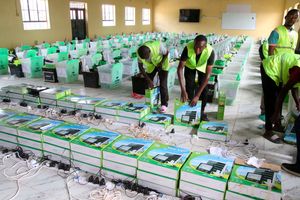Turkana Wellness Centre, a safe haven for SGBV survivors

The reporting desk for SGBV cases at the Turkana Wellness Centre found at the Lodwar County Referral Hospital on July 21, 2022.
What you need to know:
- According to the World Health Organisation, violence against children exposes them to negative coping and health risk behaviours.
- Children exposed to violence and other adversities are substantially more likely to smoke, misuse alcohol and drugs, and engage in high-risk sexual behaviour.
I meet Sisi outside Turkana Wellness Centre on the old block of Lodwar County Referral Hospital.
It is fenced off from the hospital wards with a chicken wire and so when someone walks into this space, there is a sense of confidentiality and security.
This environment makes the centre particularly friendly to sexual and gender-based violence (SGBV) survivors, whose privacy, security and tranquility come first upon rescue.
From her outward bearing, Sisi is unhappy. In a few minutes, I get to know why. Her name has been changed to protect her from further harm. A large part of her wound has yet to heal.
She was orphaned at the age of nine. With no one to look after her, she moved to the streets of Lodwar town in Turkana County, a place she called home for the next eight years.
“Life on the streets was horrible. No one bothered to help me when I begged for sponsorship to study. I had to scavenge for food from the waste,” she says.
Violated
Then, in 2014, when she was 17, something horrendous happened to her. At this point, Sisi breaks down and cries. She says, three men accosted her at night and gang-raped her.
The following day, she asked one woman in the town where she would get emergency treatment and she was directed to the facility.
At the centre, she was counselled and given an emergency contraceptive pill, averting conception, and a post-exposure prophylaxis (PEP) drug, protecting her from the risk of HIV infection.
She has turned 25 but any event that takes her back to the painful moment peels back the restored fraction of her wound. “Sometimes I cry a lot. I wish I had a mother to console me,” she says as tears rolls down her cheeks.
Her experience resonates with the findings of the Department of Children Services and Kenya National Bureau of Statistics, in its 2019 survey on violence against children. It found nearly one in six young women aged 18–24 experienced sexual violence in their childhood. While 6.4 per cent of young men suffered the same.
Protection
This wellness centre is a safe haven for Sisi. She comes here frequently for counselling without charge. She is among the more than 3,000 survivors who have benefitted from the facility started in 2014 with funding from United Nations Children's Fund (Unicef).
But her case shows the vulnerability of girls on the streets and how their risks can widen in the absence of working SGBV infrastructure. Had she not received the emergency pill, Sisi would now be raising a child against her plans. And she would be HIV-positive if the defilers were infected.
Kenya is already facing a triple threat of SGBV, resulting in teenage pregnancies and exposing adolescents to HIV infection.
In 2021, there were at least 98 new HIV cases every week among adolescents aged 10–19, according to the Ministry of Health. In the same year, about 21 per cent of the 317,644 pregnancies recorded were among the 10–19-year-olds. The data from the centre mirrors this disaster.
Girls bear brunt of SGBV
Last year, defilement was the most reported case of SGBV, with girls suffering the most. This means children were at most risk of sexual abuse in the 11 months under review. A total of 152 defilement cases were reported between January and November 2021. They included 134 girls and 18 boys.
April was the worst month for the girls when 17 cases were recorded followed by February, June and August when 14 girls were defiled, each month. Boys were most violated in February (10).
Further, nearly all cases are reported after two or three weeks, far beyond the 72-hour period when the health workers can prevent pregnancy and HIV infection with the administration of respective drugs, elaborates centre clinician Elim Shadrack.
Often, cases of survivors between three to 10 years, are reported immediately, adds centre’s ppsychosocial counsellor Hilda Ebei.
Nevertheless, the tripartite partnership between the Turkana government, which allocated the space for setting up the facility, the centre and Unicef has greatly boosted efforts to safeguard the rights of boys and girls.
Support
The survivors do not only receive psychosocial support at the centre but also get examined and DNA samples taken for testing. Lodwar police station is also a few yards away, convenient for the survivor to report, fill and submit the P3 form to the police.
Ms Ebei says had it not been for the community sensitisation the centre conducts, such cases would go unreported. “We never had people report defilement or intimate partner violence to the police. Now they can because they are not afraid and know that no one has a right to abuse them or the children.”
She says they create awareness through churches, local leaders, community health volunteers and clubs in schools. Presently, the centre is the only facility in the county that offers comprehensive SGBV services, yet such structures are the cornerstones of sustainable protection of children against violence.
Recently, President Uhuru Kenyatta assented to Children Bill (2021), which the backers term progressive legislation as it is realigned with the 2010 Constitution.
Under the new law, a child welfare fund would be established to facilitate the realisation of children’s rights, which include childcare facilities to be established by counties.
Legal foundation
Unicef Child Protection Specialist Wilson Kisiero says the government now has the duty to effect the new law. “Let the political class invest in children…put in place systems and processes that ensure the children are protected at home, community and in school.”
He hopes that the counties will seamlessly work with the national government to safeguard the children’s rights. He says children in Turkana become more vulnerable to violence during drought as they are separated from their parents who migrate in search of pasture and water.
In response, Unicef has partnered with Turkana County and Department of Children’s Services to rescue and reunite the children with their parents. This is alongside strengthening referral and pathway systems in the county to comprehensively respond to the needs of the children, including food and nutrition
“It is not enough to protect children from violence, it is also important that they have access to life-saving products such as food,” he said.
In the coming months, he says they will be facilitating sensitisation drives and supporting training for community health workers in how to respond to and prevent violence against children.
Online child abuse
He lauded the Act for recognising online abuse of children as this paved the way for stringent protective measures. The new law has prohibited exposure of children to electronic or online prostitution or pornography.
A joint 2021 study by End Child Prostitution and Trafficking, International Criminal Police Organisation and Unicef found between five and 13 per cent of internet-using children, aged 12–17, had been exposed to online child sexual exploitation in the past year.
The survey, Disrupting Harm Kenya, sampled children aged 12–17 and their caregivers. The children were asked whether they had been subjected to a range of potential and actual instances of online child sexual exploitation and abuse within the past year.
The study recommends educating children on how to stay safe by “setting boundaries, recognising appropriate and inappropriate behaviour from adults and those around them and how to say no to inappropriate behaviour”.
It also offers a suggestion for internet service providers to filter and remove child sexual abuse material to keep children safe online.
For the government, it proposes operationalising Victim Protection Trust Fund to facilitate access to counselling and medical care where there are no pro bono services.
Often children’s risks to sexual violence is heightened by peer pressure, poverty where children exchange sex for money, have alcohol abusing parents, and live in communities that uphold myths that sex with a virgin cures HIV.
To address these challenges, among others, the government, as outlined in the National Prevention and Response Plan on Violence against Children in Kenya (2019–23), commits to creating working frameworks for prosecuting offenders besides supporting violated girls to resume learning even after delivery.
Spot it! Spot it!
In response to the significant experience and threat of violence faced by children in Kenya, in 2020, Unicef partnered with the Department of Children Services to launch ‘Spot it! Stop it!’ campaign, a social and behaviour change communication intervention.
With this campaign, Unicef hopes to foster a multi-pronged approach to combating violence against children by encouraging communities to be vigilant and responsive.
Violence against children is costly and leaves economies withered from excessive expenditures on addressing the damages of the harm.
ChildFund Alliance estimates that global economic impacts and costs resulting from the consequences of physical, psychological, and sexual violence against children can be as high as $7 trillion. This massive cost it says is higher than the investment required to prevent much of that violence.
Kenya loses Sh46 billion annually due to SGBV. This translates into about 1.1 per cent of Kenya’s gross domestic product. This is enough to build 657 level 3 hospitals in Turkana County, which is the second largest county in Kenya with 68,232 square kilometres.
Violence has long-term effects on children. According to the World Health Organisation, violence against children exposes them to negative coping and health risk behaviours. That children exposed to violence and other adversities are substantially more likely to smoke, misuse alcohol and drugs, and engage in high-risk sexual behaviour.
They also have higher rates of anxiety, depression, and suicide. Further, for girls it leads to unintended pregnancies, induced abortions, gynecological problems, and sexually transmitted infections, including HIV. “We must all work together to end violence against children,” concluded Mr Kisiero





